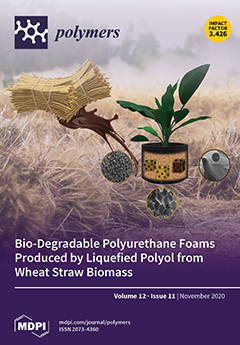In the present study, a novel graft modified flocculant CTS-g-PAMD was synthesized and applied to conduct sludge conditioning and dewatering. CTS-g-PAMD was copolymerized with AM, DMC and chitosan (CTS) under UV-H
2O
2 initiation. In addition, the effects of single factor experiments
[...] Read more.
In the present study, a novel graft modified flocculant CTS-g-PAMD was synthesized and applied to conduct sludge conditioning and dewatering. CTS-g-PAMD was copolymerized with AM, DMC and chitosan (CTS) under UV-H
2O
2 initiation. In addition, the effects of single factor experiments on the molecular weight (MW) CTS grafting efficiency (GE) of CTS-g-PAMD were determined and the optimal copolymerization conditions were achieved. The GE of CTS-g-PAMD reached 91.1% and the MW was 4.82 × 10
6 Da. As revealed from the characterized results of Fourier-transform infrared spectra (FT-IR),
1H/ NMR, X-ray diffraction (XRD), scanning electron microscopic (SEM) and X-ray photoelectron spectroscopy (XPS), the successful synthesis of CTS-g-PAMD was confirmed, which is considered to be conducive to explaining sludge dewatering performance. Under the optimal conditions (pH = 7.0, flocculant dosage = 35 mg/L), the best flocculating performance (FCMC: 73.7%; SRF: 4.7 × 10
12 m·kg
−1, turbidity: 9.4 NTU) and large and dense sludge flocs (floc size d
50 = 379.142 µm, floc fractal dimension D
f = 1.58) were formed. The DMC and CTS chain segments exhibiting cationic properties significantly improved the positive charge density and enhanced the electrical patching effect of CTS-g-PAMD. The long molecular chain of CTS-g-PAMD exhibited superior extensibility, which enhanced bridging effect on adsorption. Moreover, the sludge floc after undergoing CTS-g-PAMD conditioning exhibited robust shear resistance and regeneration ability. After the sludge floc was crushed and broken, a large and dense sludge floc was formed, helping significantly reduce the sludge specific resistance (SRF), turbidity and cake moisture content (FCMC) and enhance the sludge dewatering effect. The novel CTS-g-PAMD flocculant shows promising practical applications and high market value.
Full article






